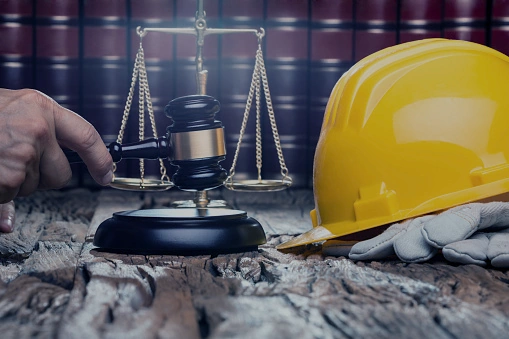Workplace environment and type are important factors in determining the risk of workplace injuries. However, due to increased safety measures, the most common work-related injuries and fatalities have decreased over the years.
Knowing the most common injury in the workplace and how to prevent them is critical for reducing workplace accidents and worker deaths.
Slips, trips, falls, and overexertion injuries are all common workplace injuries. If you are injured at work, don’t hesitate to seek medical attention, no matter how minor the injury is.
What Are the Most Common Workplace Injuries?
Slip, Trip, and Fall Injuries
Slip, trip, and fall accidents are common in workplaces and are responsible for most worker-filed personal injury claims. It includes workers who:
- Slipped on a wet, oily, or icy floor
- Fell off ladders, roofs, or elevated platforms
- Tripped due to clutter, poor lighting, or unprotected sides
Trip and fall accidents are common among construction workers and frequently result in serious injuries such as spinal cord damage, broken bones, and soft tissue damage such as strained or torn ligaments.
Workers can, however, avoid these accidents by being aware of their surroundings and wearing the appropriate protective equipment. Employers should also provide routine occupational safety training to their employees and equip them to clean up debris and spills as soon as possible.
Bodily Reaction and Overexertion
Overexertion injuries, such as repetitive strain injuries, can cause long-term debilitating pain, such as carpal tunnel syndrome, as well as a loss of productivity. This type of workplace injury is frequently caused by:
- Lifting heavy objects manually
- Improper lifting technique
- Jumping on another level
- Microtasks on a factory line
- Heavy pushing, carrying or throwing
- Typing or using a mouse without good ergonomics
- Repetitive work without a break
Employers must train employees to correctly perform physical tasks in order to avoid muscle strains and other work-related injuries.
Workplace injuries can occur as a result of a single incident or years of strenuous work activities.
Workers performing repetitive motion or lifting tasks, on the other hand, can reduce the risk of overexertion and its potential long-term consequences by taking frequent breaks and using mechanical lifting equipment for weights greater than 50 pounds.
Struck by Equipment, Falling Objects, or Other Worker’s
We’ve all walked into sharp edges or a wall, but these injuries can be severe when working in a high-risk industry, as they frequently result in blindness, severed fingers or limbs, stress fractures, and other serious injuries. The following are the primary causes of these injuries:
- Dropped loads
- Falling tools, materials, or debris
- Excessive vibration
- Walking into hard surfaces or machinery
- Bumping into equipment or object
Collision or Crashes
You run the risk of being injured in a car accident whether you work around them or drive them. For example, if you work in a large warehouse, you may be hit or run over by a forklift. Other common causes of workplace crashes or collision injuries include:
- Falling from a vehicle
- Being stuck under an overturned vehicle
- Getting struck by objects falling from a vehicle
When operating motorized vehicles in the workplace, employees must wear seat belts. Furthermore, all workers in vehicle-operating environments should learn to be self-aware and follow established safety regulations.
Exposure to Harmful Substances and Environments
Individuals who work with hazardous chemicals or in noisy environments risk severe skin, eye, ear, and respiratory system injuries if they do not wear proper protective equipment.
As an employee, make sure you are familiar with chemical safety information and that you are wearing personal protective equipment such as gloves, ear protection, safety goggles, and other necessary safety gear to avoid exposure to hazardous substances.
Injuries Caused by Persons or Animals
Fights aren’t supposed to happen at work, but they do. Employees or customers may engage in aggressive confrontations as a result of accumulated stress and tension, resulting in intimidation, harassment, and even physical assault.
Workplace violence can also result from workplace disagreements. Individuals who work on farms, forests, and other establishments such as wildlife reserves are also vulnerable to animal attacks.
As an employer, enacting a zero-tolerance policy for all individuals who interact with company personnel is an excellent way to avoid workplace violence. When working with animals, you can reduce your risk of injury by staying alert and following the established safety guidelines.
Explosions and Fire
Fires and explosions can cause significant damage to body tissue and the respiratory system, as well as disfigurement, but this type of workplace injury is uncommon. However, it has the highest number of casualties.
Explosion-related injuries are classified into four categories based on the level of impact on the human body. Among the categories are:
- Primary blast: It results from blast waves unique to high-order explosions
- Secondary blast: This injury is caused by debris or flying objects displaced by the explosion
- Tertiary blast: injury caused by structure collapse or a displacement through the air
- Quaternary blast: all other explosion-related injuries, including radiation exposure, burns, crush injuries, and inhalation of toxic substances
What Next After Suffering a Work-related Injury?
If you’re not sure what to do after an injury, you’re not alone. This article discusses the critical steps to take following a workplace injury. These steps are critical, and getting the process started as soon as possible is critical.
If you are eligible for workers’ compensation or have a claim outside of it, the following procedure is critical for securing and maximizing your potential recovery:
Inform Your Employer of the Accident
To receive workers’ compensation benefits, most states in the United States require employees to report accidents to their employers. However, if you are not eligible for workers’ compensation, you must file a personal injury claim if the circumstances surrounding your injury necessitate it.
It should be noted that personal injury and workers’ compensation claims are not the same. Personal injury cases are based on fault and the at-fault party, whereas workers’ compensation claims, are not based on fault.
Because some states only provide a seven-day window for reporting a work-related injury, you must act quickly.
Seek Medical Attention
Seeking medical attention is critical to protecting your legal rights and, more importantly, your health. The sooner you are diagnosed, the sooner you can begin your recovery. Furthermore, seeking immediate medical attention will allow you to obtain a doctor’s diagnosis indicating that your injury is work-related.
Keep Any and Every Evidence in Your Possession
If you took photos of the accident or have old pictures of yourself that show you were injured, keep them along with any other physical evidence related to the accident and your injury. The evidence you have could be crucial in your benefits claim.
Document All You Remember About the Accident
What happened leading up to the accident? Were there any eyewitnesses? Did you notice anything before or after the accident that could have contributed to your injury? There is no small detail, and you should provide your injury lawyer with as much information as possible.
Be Smart About Guarding Your Rights
There are numerous ways you can jeopardize your claim for financial compensation, ranging from online activities to discussions with an insurance adjuster. Be mindful and cautious when discussing the details of the accident, whether online or in person. Allow your lawyer to be the only person you speak with about the case if at all possible.
Schedule for Consultation with a Local Injury Lawyer
Hiring an injury lawyer is the best way to obtain compensation. Your lawyer knows everything there is to know about injury claims and is in the best position to guide, advise, and protect you from insurance companies.
How Do I File for Workers’ Compensation After an Injury at Work?
The procedures for filing a workers’ compensation claim differ by state. However, in general, the process entails reporting the injury to your employer, seeking medical treatment from a pre-approved provider, and coordinating with your employer (or their insurance company) to obtain your benefits.
However, these steps are not always simple, as you may face some difficulties, so you must exercise caution when handling a case like this: consider hiring an experienced injury lawyer for your injury case.
Your lawyer will gather evidence on your behalf, file a claim, negotiate with insurance companies, and appear in court if necessary so that you can receive benefits to cover your medical expenses and other losses.
Need a Lawyer’s Help for Your Injury Case? Gregory Spektor & Associates Is One Call Away!
When safety policies, training, and protective equipment fail, workers who are injured in workplace accidents are entitled to compensation. However, the procedures for filing for and receiving financial benefits can be complicated.
Perhaps you were injured in a workplace accident or are suffering from an injury caused by the cumulative effect of your job; Gregory Spektor & Associates can assist you. Call us at 1(800)-318-8888 right now.


